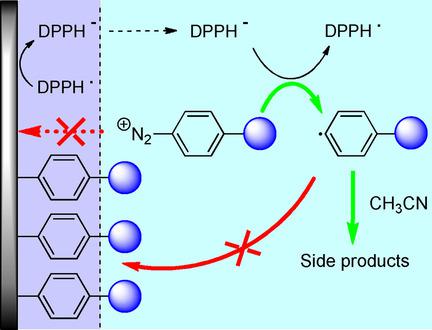当前位置:
X-MOL 学术
›
ChemElectroChem
›
论文详情
Our official English website, www.x-mol.net, welcomes your feedback! (Note: you will need to create a separate account there.)
Diazonium Grafting Control through a Redox Cross‐Reaction: Elucidation of the Mechanism Involved when using 2,2‐Diphenylpicrylhydrazyl as an Inhibitor
ChemElectroChem ( IF 4 ) Pub Date : 2018-02-19 , DOI: 10.1002/celc.201701331 Isidoro López 1 , Marius Cesbron 1 , Eric Levillain 1 , Tony Breton 1
ChemElectroChem ( IF 4 ) Pub Date : 2018-02-19 , DOI: 10.1002/celc.201701331 Isidoro López 1 , Marius Cesbron 1 , Eric Levillain 1 , Tony Breton 1
Affiliation

|
Investigation into the mechanism involved in the control of layer growth through the reduction of diazonium salts by using 2,2‐diphenylpicrylhydrazyl (DPPH). This approach, previously assumed to be based on the radical capture of highly reactive aryl intermediates via the scavenging activity of DPPH, actually rests on redox cross reactions involving its electro‐reduced form. A numerical approach was developed to model the proposed processes, involving a redox reaction between diazonium cations and the reduced species of DPPH as a central step. Extension of this approach was validated by using substituted benzoquinones instead of DPPH, leading to good control of the radical polymerization to give sub‐monolayer surface coverage. Modulation of the surface coverage can be obtained by adjusting the concentration of the redox mediator and a near‐monolayer can be prepared in this way. The difference in formal redox potential between the diazonium salt and the electro‐reducible mediator was identified as a key parameter, and could be exploited to generalize the grafting control.
中文翻译:

通过氧化还原交叉反应控制重氮接枝:使用2,2-二苯基吡啶甲基肼基作为抑制剂时所涉及的机理的阐明
通过使用2,2-二苯基吡啶甲基肼基(DPPH)还原重氮盐来控制层生长的控制机理的研究。该方法以前被认为是基于通过DPPH的清除活性自由基捕获高反应性芳基中间体的方法,实际上是基于涉及其电还原形式的氧化还原交叉反应。开发了一种数值方法来对拟议的过程进行建模,其中涉及重氮阳离子与DPPH还原物种之间的氧化还原反应。通过使用取代的苯醌代替DPPH验证了这种方法的扩展,从而可以很好地控制自由基聚合反应,以提供亚单层表面覆盖。可以通过调节氧化还原介体的浓度来调节表面覆盖率,并可以用这种方法制备接近单层的膜。重氮盐和电还原介体之间的形式氧化还原电势的差异被确定为关键参数,可用于推广接枝控制。
更新日期:2018-02-19
中文翻译:

通过氧化还原交叉反应控制重氮接枝:使用2,2-二苯基吡啶甲基肼基作为抑制剂时所涉及的机理的阐明
通过使用2,2-二苯基吡啶甲基肼基(DPPH)还原重氮盐来控制层生长的控制机理的研究。该方法以前被认为是基于通过DPPH的清除活性自由基捕获高反应性芳基中间体的方法,实际上是基于涉及其电还原形式的氧化还原交叉反应。开发了一种数值方法来对拟议的过程进行建模,其中涉及重氮阳离子与DPPH还原物种之间的氧化还原反应。通过使用取代的苯醌代替DPPH验证了这种方法的扩展,从而可以很好地控制自由基聚合反应,以提供亚单层表面覆盖。可以通过调节氧化还原介体的浓度来调节表面覆盖率,并可以用这种方法制备接近单层的膜。重氮盐和电还原介体之间的形式氧化还原电势的差异被确定为关键参数,可用于推广接枝控制。



























 京公网安备 11010802027423号
京公网安备 11010802027423号